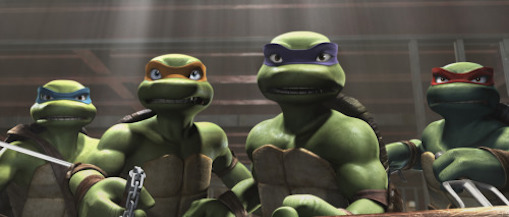The Number One Movie in America: TMNT
By Sean Collier
August 29, 2020
The Ninja Turtles don’t really go away.
While there are lulls in the cultural primacy of the subterranean superheroes, there have been no TMNT-free moments since the quartet rose to prominence in the mid-’80s. The silver screen is no exception; after a series of hit films in the early ’90s, a slick (and critically reviled) CGI/live-action series launched to massive global returns in the mid-’10s.
There was also a forgotten Turtle picture in the middle. And, while it’s barely remembered today, it was a hit. (Like everything in the franchise.)
“TMNT,” the only fully animated, theatrical Turtles release, premiered on March 23, 2007. It was one of those weekends when the studios throw a bevy of releases at the multiplex to see what hits; a shocking six new, wide releases appeared in that weekend’s Top 10, also including “Shooter,” “The Last Mimzy,” “The Hills Have Eyes 2,” “Reign Over Me” and “Pride.”
The Turtles, who by this point had the coveted cross-generational hook (parents, take your kids to see the characters you loved when you were young), climbed to the top of that heap, winning the weekend with a relatively soft $24.2 million. (The competition didn’t come from “Shooter,” but rather from surprise hit “300,” which was the runner-up in its third weekend.) “TMNT” didn’t have legs, falling out of the top ten just three weeks later, but pulled in a quietly profitable $54.1 million at domestic theaters.
As a film, it’s curious. It feels like an intermediary story, as it exists as a soft sequel to the ’90s films; franchise villain Shredder is nowhere to be found in this installment, since he didn’t make it out of the previous trilogy. (In his place is a sinister business tycoon voiced by Patrick Stewart.) At least it’s not an origin story; when we join the Turtles, Leonardo is undergoing an extended period of soul-searching in central America (that’s as geographically specific as the movie gets) while the other turtles wait around for him to return.
“TMNT” has some impressive sequences; a rooftop fight between Leonardo and a disguised Raphael is fun, and Michaelangelo skateboards through the sewers with typical dazzle. The images themselves are ugly, with an animation style that can best be described as swampy, but the direction, by animation journeyman Kevin Munroe, is fine.
“TMNT” is just kinda there, with neither the oddball charm of the earlier films nor the abrasive crappiness of the later Turtles pictures. It’s a Ninja Turtle movie. It does what it says on the tin.
So, without trying, it became the number one movie in America. In fact, every Ninja Turtles movie released in theaters reached number one. The 1990 “Teenage Mutant Ninja Turtles” won four weekends and became the fifth best-grossing film of the year. The most recent, the critically reviled and underwhelming “Out of the Shadows,” still opened to a win, with more than $35 million. Even the 1993 afterthought “Teenage Mutant Ninja Turtles III” won two weekends.
The box office results end like every story involving these four: The Turtles win.
“TMNT” is the subject of the latest episodes of The Number One Movie in America, a look back at past box-office champions. Each episode’s film is drawn at random from a list of every number-one movie since 1982. Please listen and subscribe!
Next time: Robert Shaw stars in an adaptation of a Peter Benchley novel. It’s ... not the one you're thinking of.
|
|
|
|




